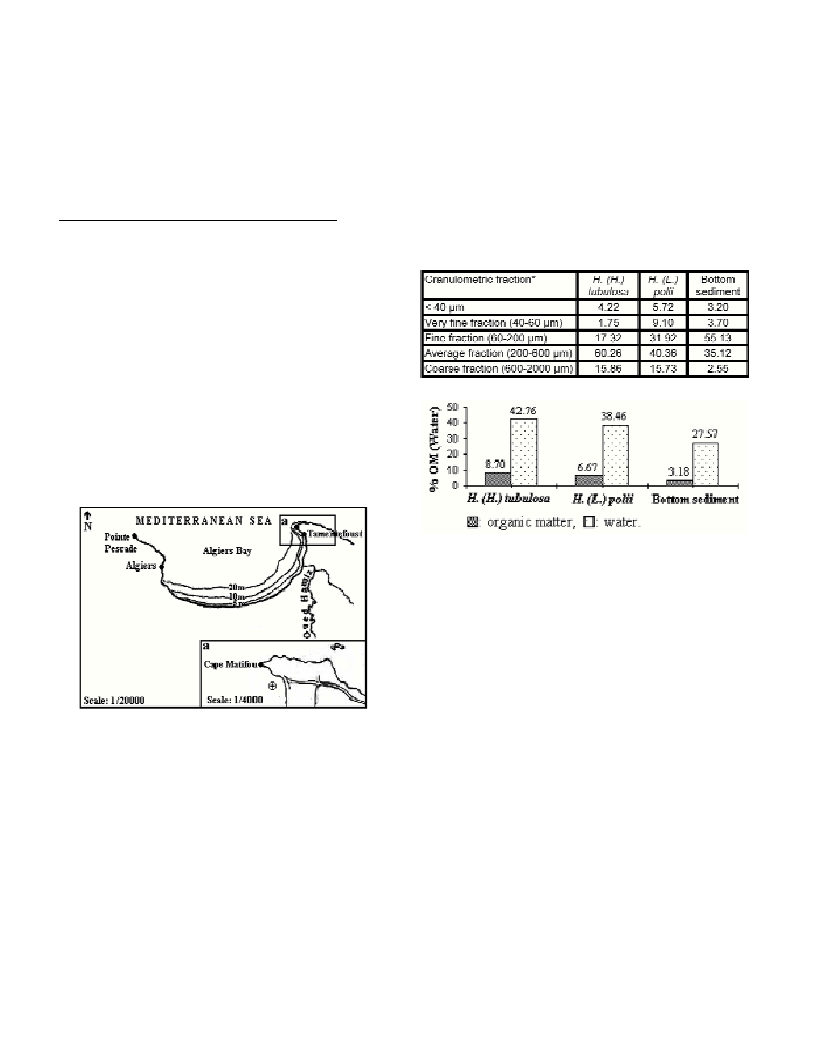FEEDING BEHAVIOUR OF HOLOTHURIA TUBULOSA AND HOLOTHURIA POLII
OF TAMENTEFOUST AREA - ALGERIA
Karim Mezali
Faculté des Sciences et Sciences de l’ingénieur, Mostaganem, Algérie - mezalikarim@yahoo.fr
Abstract
The feeding behaviour of Holothuria tubulosa andH. polii was carried out in one shallow water area characterised by Posidonia meadow.
The morphometric characteristics of the ingested particles and their organic matter and water contents were compared to the bottom
sediment. The results illustrate the alimentary specificity of each species, which ingest average and fine sediment fraction. The two species
are able to discriminate between particles rich and poor in nutritive elements.
Keys-words: Echinodermata, organic matter, sediments
Rapp. Comm. int. Mer Médit., 37,2004
535
Introduction
Holothurians are major component of Posidonia meadow [1]. They
play an important rule in recycling of the organic matter and the oxy-
genation of the bottom [2]. They feed by scraping particulate deposits
and selecting organically rich materials using their tentacles.
Holothurians ingest the sediment for its nutritive particles [3], bacte-
ria [4], meiofauna [5] and marine phanerogams leaves [6, 7].
Material and methods
The sampling was done during April-May 2001 in one station of -
3m depth (Fig. 1). Two batches composed of ten individuals of each
species were taken. The water rates of the bottom and pooled guts
sediments (first batch) are obtained by weighting before and after
desiccation (24h at 105 °C) and the organic matter (OM) is calculated
after passing the sediment in oven (2h at 550 °C) using the formulas:
% Water= (1 - DW/ WW) x 100; % OM= (1- AW/ DW) x 100 (WW=
Wet Weight; DW= Dry Weight; AW= Ash Weight)
[
8
]
.The bottom
and the pooled guts sediments [9] (second batch) are dried (24h at
105°C), weighted and sieved mechanically (AFNOR sieves). The
contents of each sieve are weighted and percentage of the fractions
[10] is calculated.
Results and discussion
Organic matter and water
The high rate of OM obtained in the gut sediment (p> 0.01) (Fig. 2)
show that the two species have a tendency to select OM from the bot-
tom. The water overvaluation in the gut sediment is in close relation-
ship with the increase of the OM (Fig. 2). Indeed, more the OM is
high; more it requires water to ingest it. The difference in OM noted
in the gut of the two species could be related to their biota. H. tubu-
losaexist between Posidonialeaves, which are responsible for the
accumulation of the detritus [11]. H. poliiprefers the sandy bottom
in?uenced by hydrodynamism that disperses food.
Granulometry
The bottom sediment is characterized by high rate of fine fraction
(55,13%) (Tab. 1). The predominance of this fraction is related to OM
concentration [12]. It seems that H. polii, has a tendency to select this
fraction. Generally,H. tubulosa andH. poliiprefers the average frac-
tion (40.36-60.26%) (Tab. 1). The difference noted in selection of the
particles could be related to its charge in OM and to the difference
existing in the texture of the tentacles [13]. Indeed, according to [6],
H. tubulosais able to know particles covered by OM.
References
1-Azzolina J.F., and Harmelin J.G., 1989.Répartition et ?uctuations de
densité de trois espèces d’holothuries (Echinodermata). Pp. 219-230.In:
Boudouresques C.F., Meinesz A., Fresi E. and Gravez V. (ed.), GIS
PosidoniePubl., Marseille.
2-Charbonnel E., Gravez V., Abellard O., Boudouresque C.F., and
Remonnay L., 1995. Surveillance de l’herbier de Posidonies du golf de
Giens. Pp. 1-106. GIS PosidoniePubl., Marseille.
3-Coulon P., and Jangoux M., 1993. Feeding rate and sediment
reworking by Holothuria tubulosain a Mediterranean seagrass bed off
Ischia Island, Italy. Mar. Ecol. Prog. Ser., 92: 201-204.
4-Yingst J.Y., 1976. The utilisation of organic matter in shallow marine
sediments by epibenthic deposit feeding holothurian.J. exp. Mar. Biol.
Ecol.,23:55-69.
5-Berthon J.F., 1987. Relations trophiques entre quelques espèces
d’échinodermes et le phytobenthos dans la baie de Port-Cros. DEA, Univ.
Pierre et Marie Curie, Fr., 72 p.
6-Massin C., and Jangoux M., 1976.Observations écologiques sur
Holothuria tubulosa,H. polii et H. forskaliet comportement alimentaire
de H. tubulosa. Cah. Biol. Mar., 17: 45-59.
7-Verlaque M., 1981. Preliminary data on some Posidoniafeeders.Rapp.
Comm. Int. Mer Médit., 27 (2): 201-202.
8-Massin M., 1980. The sediment ingested by Holothuria tubulosa. Pp.
205-208. In:Jangoux M. and Lawrence J.M. (ed.), Echinoderms: Present
and Past. Belkema A.A., Publ., Rotterdam.
9-Roberts D., 1979. Deposit feeding mechanisms and resource
partitioning in tropical holothurians. J. Exp. Mar. Biol. Ecol., 37:43-56.
10-Berthois L., 1975. Etudes sédimentologiques des roches meubles.
278 p. In: Doin (ed.),Paris.
11-Boudouresque C.F., and Jeudy De Grissac A., 1983. L’herbier à
Posidonia oceanicaen Méditerranée: les interactions entre la plante et le
sediment. J. Rech. Océanogr., 8: 99-122.
12-Berthois L., Crosnier A., and Le Calvez Y., 1968. Contribution à
l’étude sédimentologique du plateau continental dans la baie de Biafra.
Cah. ORSTOM, Vl: 1-34.
13-Roberts D., and Bryce C., 1982. Further observations on tentacular
feeding mechanisms in holothurians.J. Exp. Mar. Biol. Ecol., 59: 151-163.
Fig. 1. Situation of the Tamentefoust station. A = detail. + = sampling
area.
Fig. 2. Gut and bottom organisc matter and water percentage.
Table 1. Gut and bottom fractions percentages. *: Classification accor-
ding to [12].

